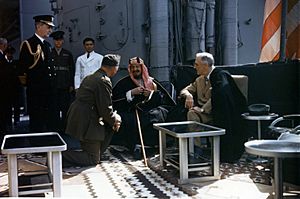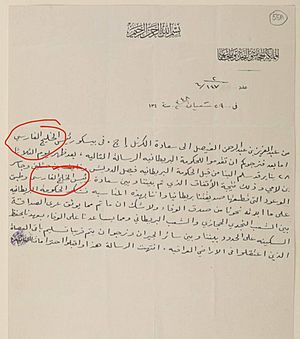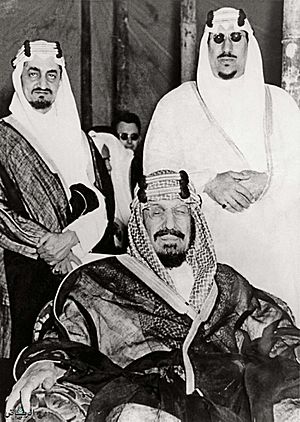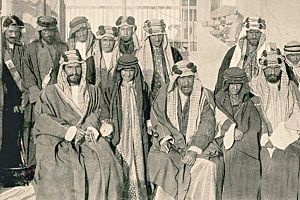Ibn Saud facts for kids
Quick facts for kids Ibn Saud |
|||||
|---|---|---|---|---|---|
| Imam of Nejd | |||||

Official portrait, 1940s
|
|||||
| King of Saudi Arabia | |||||
| Reign | 23 September 1932 – 9 November 1953 | ||||
| Bay'ah | 23 September 1932 | ||||
| Predecessor | Post established | ||||
| Successor | Saud | ||||
| Emir/Sultan/King of Nejd | |||||
| Reign | 13 January 1902 – 23 September 1932 | ||||
| Predecessor | Abdulaziz bin Mutaib (as Emir of Jabal Shammar) | ||||
| Successor | Himself (as King of Saudi Arabia) | ||||
| King of Hejaz | |||||
| Reign | 8 January 1926 – 23 September 1932 | ||||
| Predecessor | Ali bin Hussein | ||||
| Successor | Himself (as King of Saudi Arabia) | ||||
| Born | 15 January 1875 Riyadh, Nejd |
||||
| Died | 9 November 1953 (aged 78) Shubra Palace, Ta'if, Saudi Arabia |
||||
| Burial | Al Oud cemetery, Riyadh | ||||
| Spouse |
See list
Wadha bint Muhammad Al Orair
Tarfa bint Abdullah Al Sheikh Luluwah bint Salih Al Dakhil Al Jawhara bint Musaed Al Jiluwi Lajah bint Khalid bin Hithlain Bazza I Jawhara bint Saad Al Sudairi Hussa bint Ahmed Al Sudairi Shahida Fahda bint Asi Al Shuraim Bazza II Haya bint Saad Al Sudairi Bushra Munaiyir Mudhi Nouf bint Nawaf bin Nuri Al Shaalan Saida Al Yamaniyah Khadra Baraka Al Yamaniyah Futayma Mudhi bint Abdullah Almandeel Al Khalidi Possibly other wives |
||||
| Issue among others... |
See list
Prince Turki I
King Saud King Faisal Prince Muhammad Prince Nasser King Khalid Prince Saad Prince Mansour King Fahd Prince Bandar Prince Musa'id King Abdullah Prince Abdul Muhsin Prince Mishaal Princess Qumash Prince Sultan Princess Al Bandari Princess Sultana Princess Luluwah Princess Haya Princess Seeta Prince Abdul Rahman Prince Mutaib Prince Talal Prince Mishari Prince Badr Prince Turki II Prince Nawwaf Prince Nayef Prince Fawwaz King Salman Prince Majid Prince Thamir Prince Abdul Illah Princess Madawi Prince Mamdouh Prince Sattam Prince Ahmed Prince Abdul Majeed Prince Hathloul Prince Mashour Prince Muqrin Prince Hamoud Princess Al Jawhara Princess Latifa Princess Nouf |
||||
|
|||||
| House | House of Saud | ||||
| Father | Abdul Rahman bin Faisal, Emir of Nejd | ||||
| Mother | Sara bint Ahmed Al Sudairi | ||||
| Occupation |
|
||||
| Military career | |||||
| Allegiance | Saudi Arabia | ||||
| Battles/wars |
|
||||
Abdulaziz bin Abdul Rahman Al Saud (Arabic: عبد العزيز بن عبد الرحمن آل سعود; 15 January 1875 – 9 November 1953), known as Ibn Saud (Arabic: ابن سعود), was an important Arab leader. He founded Saudi Arabia and became its first king on 23 September 1932. He ruled until his death in 1953. Before becoming king, he had already ruled parts of the region since 1902. He was known as an Emir, Sultan, and King of different areas like Nejd and Hejaz.
Ibn Saud was the son of Abdul Rahman bin Faisal, Emir of Nejd. His family was forced to leave their home in Riyadh in 1890. In 1902, Ibn Saud bravely took Riyadh back. This started 30 years of battles that made him the ruler of most of central and northern Arabia. He took full control of the Nejd region by 1922 and then conquered the Hejaz in 1925. In 1932, he united these lands into the Kingdom of Saudi Arabia. During his rule, oil was discovered in Saudi Arabia in 1938. This led to a lot of oil production after World War II. Ibn Saud had many children, including 45 sons. All the kings of Saudi Arabia after him have been his sons.
Contents
Early Life and Family History
The Al Saud family had been powerful in central Arabia for about 130 years. They had tried to control much of the Arabian Peninsula before. This was known as the First Saudi State. But an army from the Ottoman Empire destroyed it in the early 1800s.
Abdulaziz bin Abdul Rahman, also called Ibn Saud, was born in Riyadh on 15 January 1875. He was the fourth child and third son of Abdul Rahman bin Faisal. His father was one of the last rulers of the Second Saudi State, which was based in Riyadh. Ibn Saud's mother was Sara bint Ahmed. She passed away in 1910. He had several brothers and sisters. Some of his half-brothers, like Muhammad and Abdullah, later helped in the Saudi government. Ibn Saud learned to read the Quran in Riyadh.
Exile and Taking Back Riyadh
In 1891, the Al Saud family's rivals, led by Muhammad bin Abdullah Al Rashid, took over Riyadh. Ibn Saud was 15 years old then. He and his family first found safety with a Bedouin tribe in the southern desert. Later, the Al Sauds moved to Qatar and then briefly to Bahrain. The Ottoman State allowed them to live in Kuwait, where they stayed for almost ten years. Ibn Saud became friends with the ruler of Kuwait, Mubarak Al Sabah.
On 14 November 1901, Ibn Saud and about 40 men began a journey to take back Riyadh. They used tilted palm trees to climb over the city walls on the night of 15 January 1902. They successfully captured the city. The Rashidi governor of Riyadh was killed during the takeover. This victory marked the start of the Third Saudi State. Soon after, Ibn Saud's younger brother, Saad, brought 70 more warriors from Kuwait to help. Ibn Saud then made his home in the palace of his grandfather in Riyadh.
Becoming a Powerful Leader
After taking Riyadh, many people who supported the Al Saud family joined Ibn Saud. He was a strong leader and made sure his men had weapons. Over the next two years, he and his forces took back almost half of the Nejd region from the Rashidis.
In 1904, the Rashidis asked the Ottoman Empire for military help. The Ottomans sent troops to Arabia. Ibn Saud's forces faced a big defeat in June 1904. But they regrouped and started fighting the Ottomans using guerrilla warfare (small, surprise attacks). This made it hard for the Ottomans to get supplies, forcing them to leave. By October 1906, Ibn Saud's victory in the Battle of Rawdat Muhanna ended the Ottoman presence in Nejd.
Ibn Saud finished conquering Nejd and the eastern coast of Arabia by 1912. He then formed the Ikhwan, a group of religious fighters. They helped him in his later conquests. He also started a plan to settle the nomadic Bedouin tribes into new communities. This helped them become loyal to the Ikhwan and the new state.
In 1915, the British government signed the Treaty of Darin with Ibn Saud. This agreement made his lands a British protectorate (meaning Britain would protect them). In return, Ibn Saud promised to fight against Ibn Rashid, who was an ally of the Ottomans. The British also gave him weapons and money. After World War I, he received even more support from the British. He used this to fight the Al Rashidi, almost destroying them by 1922.
In 1922, Ibn Saud signed a new treaty with the British at Uqair. This treaty recognized many of his land gains. In exchange, he agreed to respect British territories in the area, especially along the Persian Gulf coast and in Iraq.
In 1925, Ibn Saud's forces captured the holy city of Mecca from Sharif Hussein. This ended 700 years of Hashemite rule there. On 8 January 1926, the leaders in Mecca, Medina, and Jeddah declared Ibn Saud the King of Hejaz. He also made Nejd a kingdom on 29 January 1927. On 20 May 1927, the British government signed the Treaty of Jeddah. This treaty recognized the independence of Hejaz and Nejd, with Ibn Saud as their ruler.
By 1927, Ibn Saud's forces had taken over most of central Arabia. However, the Ikhwan, his military-religious group, rebelled when Ibn Saud stopped them from raiding other areas. He tried to meet with their leaders in 1928, but they did not come. The Ikhwan Revolt began, but Ibn Saud defeated them in the Battle of Sabilla in March 1929.
On 23 September 1932, Ibn Saud officially united his lands into the Kingdom of Saudi Arabia. He became its first king. He moved his court to Murabba Palace in 1938. This palace remained his home and the government's center until he died in 1953.
Oil Discovery and His Rule
Oil was found in Saudi Arabia in 1938 by an American company called SoCal. Ibn Saud had given them permission to search for oil in 1933. He later gave American oil companies a lot of power over Saudi oil fields in 1944. Starting in 1915, he also signed an agreement with Britain to keep his forces peaceful and stop attacks on British-protected areas.
The new oil wealth gave Ibn Saud great power and influence. He made many nomadic tribes settle down and stop their small wars. He also started to spread the new kingdom's ideas, which were based on the teachings of Muhammad Ibn Abd al-Wahhab.
The King set up a Shura Council for the Hejaz region in 1927. This council later grew to 20 members and was led by Ibn Saud's son, Prince Faisal.
Foreign Relations and Wars
Ibn Saud gained loyalty from tribes near Saudi Arabia, including some in Jordan. For example, he built strong ties with Rashed Al-Khuzai. In 1934, Saudi Arabia won the Saudi-Yemeni War against Yemen. This was the first modern war between Arab states. The Saudis used British armored cars and French tanks.
In 1937, Prince Rashed Al Khuzai and his followers moved to Saudi Arabia. They lived there for several years under Ibn Saud's care.
Helping His People
Ibn Saud was known for his kindness to his people. He often gave money to those who were poor. People would eagerly wait for him in villages, towns, and even the desert.
Once, an elderly woman thanked him, and the King ordered ten bags of money to be given to her. He even sent his aid to help her carry the money home. Another time, he saw an old man who was cold and had no clothes. Ibn Saud took off his own cloak and gave it to the man. He also gave him money to help with his daily needs.
Because there were many poor people, Ibn Saud created a guest house called "Thulaim." Here, food like rice, meat, and porridge was given to the needy. As the economy got worse, Ibn Saud increased his help. He gave "royal kits" of bread and "waayid," which were yearly money gifts. The King said, "I haven't obtained all this wealth by myself. It is a blessing from Allah, and all of you have a share in it."
Later Years

Ibn Saud kept Saudi Arabia neutral during World War II. However, he was generally seen as favoring the Allies.
Towards the end of the war, Ibn Saud met important leaders. He met U.S. President Franklin Delano Roosevelt on 14 February 1945. This meeting happened on a ship in the Suez Canal. It set the stage for future relations between the two countries. He also met British Prime Minister Winston Churchill in February 1945. Saudis say this meeting focused a lot on the Palestine issue and was not very productive.
In 1948, Ibn Saud took part in the Arab-Israeli War. However, Saudi Arabia's help was mostly symbolic.
After naming his son Saud as crown prince, the King gave most of his duties to him. He spent most of his time in Ta'if.
Ibn Saud wanted a royal railway built from the Persian Gulf to Riyadh and then to Jeddah. His advisors thought this was an old man's silly idea. But the ARAMCO oil company built the railway for $70 million, using money from the King's oil earnings. It was finished in 1951. This railway helped Riyadh grow into a more modern city.
Personal Life
Ibn Saud was a tall man, about 1.93 to 1.98 meters (6 feet 4 inches to 6 feet 6 inches) tall. He was known for his strong, charming, and friendly personality. This earned him respect from his people and from foreign visitors. His family described him as a loving and caring man.
Ibn Saud had many wives, and many of his marriages helped create alliances with other families. He had almost one hundred children, including forty-five sons.
Ibn Saud also had a special place for saluki dogs, a breed from the Middle East. He even gave two of his salukis to a British Field Marshal.
Family Relationships
Ibn Saud was very close to his paternal aunt, Jawhara bint Faisal. From a young age, she taught him about his family's history and encouraged him to regain their lost power. When the Al Saud family lived as refugees in Kuwait, Jawhara often told Ibn Saud stories of his ancestors. She urged him to return to Nejd and take back his family's lands. She was very knowledgeable about Islam, Arab customs, and tribal relationships. She remained one of the King's most trusted advisors throughout his life. Ibn Saud visited her every day until she passed away around 1930.
Ibn Saud was also very close to his sister Noura, who was one year older than him. He often proudly said, "I am the brother of Noura." Noura died a few years before her brother, and the King was very sad about her death.
Successor
Ibn Saud chose his second son, Prince Saud, to be the next in line to the Saudi throne in 1933. His eldest son, Turki, who was the crown prince of Nejd and Hejaz, died at age 18 before his father. If Turki had not died, he would have been the Crown Prince.
Before his death, the King thought about who should be the next ruler. He favored Prince Faisal over Crown Prince Saud because Faisal had a lot of knowledge and experience. Ibn Saud saw Faisal as the most capable of his sons and often gave him important tasks in war and diplomacy. He once said, "I only wish I had three Faisals." However, he decided to keep Prince Saud as crown prince to ensure stability.
His Beliefs
Ibn Saud said, "Two things are essential to our state and our people... religion and the rights inherited from our fathers." He also said, "We know what to avoid, and we know what to accept for our own benefit."
He supported women's education. He once told St John Philby, "It is permissible for women to read."
Ibn Saud often said about the British, "The English are my friends, but I will walk with them only so far as my religion and honor will allow." He had more positive views about the United States, especially regarding money. He preferred to work with the United States for development loans.
Shortly before he died, the King said, "In my youth and manhood, I made a nation. Now, in my declining years, I make men for it." His last words to his two sons, the future King Saud and Prince Faisal, who were already having disagreements, were "You are brothers, unite!"
Death and Funeral
In his final years, Ibn Saud had heart disease and was partly blind and suffered from arthritis. In October 1953, his illness became very serious. He died in his sleep from a heart attack in Ta'if on 9 November 1953, at the age of 78. Prince Faisal was with him.
His funeral prayer was held in Ta'if. Ibn Saud's body was then brought to Riyadh. He was buried in Al Oud cemetery next to his sister Noura.
U.S. President Dwight D. Eisenhower sent a message about Ibn Saud's death on 11 November 1953. U.S. Secretary of State John Foster Dulles said that the King would be remembered for his achievements as a great leader.
Awards and Honors
| Styles of Ibn Saud |
|
|---|---|
 |
|
| Reference style | His Majesty |
| Spoken style | Your Majesty |
On 23 November 1916, British diplomat Sir Percy Cox arranged a meeting in Kuwait where Ibn Saud received the Star of India and the Order of the British Empire. He was also given the title of honorary Knight Grand Commander of the Order of the Indian Empire on 1 January 1920. He received the British Order of the Bath in 1935, the American Legion of Merit in 1947, and the Spanish Order of Military Merit in 1952.
| Decoration | Country | Date | Class | Ref. | |
|---|---|---|---|---|---|
| The Most Exalted Order of the Star of India | United Kingdom | 23 November 1916 | Knight Commander (KCSI) | ||
| The Most Excellent Order of the British Empire | United Kingdom | 23 November 1916 | Knight Commander (KBE) | ||
| The Most Eminent Order of the Indian Empire | United Kingdom | 1 January 1920 | Knight Grand Commander (GCIE) | ||
| Order of the Bath | United Kingdom | 1 January 1935 | Knight Commander (KCB) | ||
| Legion of Merit | United States | 18 February 1947 | Chief Commander Degree | ||
| Cross of Military Merit | Spain | 22 April 1952 | Grand Cross with White Decoration
(Gran Cruz con distintivo blanco) |
||
See also
 In Spanish: Abdulaziz bin Saúd para niños
In Spanish: Abdulaziz bin Saúd para niños
- King of the Sands (2012 film) – a movie about Ibn Saud








